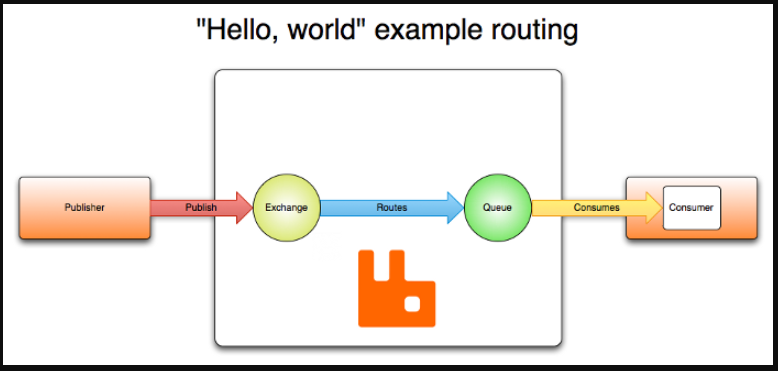1.AMQP协议
AMQP 0-9-1的工作过程如下图:消息(message)被发布者(publisher)发送给交换机(exchange),交换机常常被比喻成邮局或者邮箱。然后交换机将收到的消息根据路由规则分发给绑定的队列(queue)。最后AMQP代理会将消息投递给订阅了此队列的消费者,或者消费者按照需求自行获取。

2.相关组件
Connection:用于权限控制的虚拟主机,一个虚拟主机可以包含多个交换机、队列、绑定,可以设置不同账号,不同的权限
Channel:消息通道
Exchange:交换机,生产者将消息发送至交换机
Queue:队列,用于存储消息
Binding:绑定关系,绑定交换机与队列的关系
3.各个组件的创建
spring-boot-autoconfiguer中关于amqp的自动配置
3.1.关于我们自定义组件的初始化
①Exchange的初始
public class TopicExchange extends AbstractExchange { //交换机名称,父类AbstractExchange中的属性 private final String name; //是否持久化(默认true,重启服务后依然存在),父类AbstractExchange中的属性 private final boolean durable; //是否自动删除(默认false,长时间不用自动删除),父类AbstractExchange中的属性 private final boolean autoDelete; //参数 private final Map<String, Object> arguments; //是否延迟类型,true 发送消息的时候需要额外添加header(). //注意可能会报异常( unknown exchange type 'x-delayed-message')异常处理方法 private volatile boolean delayed; //是否内部使用,若内部使用则客户端不能发送消息 private boolean internal; public TopicExchange(String name, boolean durable, boolean autoDelete, Map<String, Object> arguments) { super(name, durable, autoDelete, arguments); } @Override public final String getType() { return ExchangeTypes.TOPIC; } }
②Queue的初始
public class Queue extends AbstractDeclarable { //队列名称 private final String name; //是否持久化 private final boolean durable; //是否声明该队列是否为连接独占,若为独占,连接关闭后队列即被删除 private final boolean exclusive; //是否自动删除,若没有消费者订阅该队列,队列将被删除 private final boolean autoDelete; //参数,可以指定队列长度,消息生存时间等队列的设置 private final java.util.Map<java.lang.String, java.lang.Object> arguments; public Queue(String name, boolean durable, boolean exclusive, boolean autoDelete, Map<String, Object> arguments) { Assert.notNull(name, "'name' cannot be null"); this.name = name; this.durable = durable; this.exclusive = exclusive; this.autoDelete = autoDelete; this.arguments = arguments; } }
③Binding的初始
public class Binding extends AbstractDeclarable { //绑定至队列或交换机 public enum DestinationType { QUEUE, EXCHANGE; } //队列或交换机名称 private final String destination; //交换机名称 private final String exchange; //绑定的路由 private final String routingKey; //参数 private final Map<String, Object> arguments; //绑定至队列或交换机 private final DestinationType destinationType; public Binding(String destination, DestinationType destinationType, String exchange, String routingKey, Map<String, Object> arguments) { this.destination = destination; this.destinationType = destinationType; this.exchange = exchange; this.routingKey = routingKey; this.arguments = arguments; } }
3.2.Connection的创建,CachingConnectionFactory定义相关属性及缓存连接
@Configuration @ConditionalOnMissingBean(ConnectionFactory.class) protected static class RabbitConnectionFactoryCreator { @Bean public CachingConnectionFactory rabbitConnectionFactory(RabbitProperties config) throws Exception { RabbitConnectionFactoryBean factory = new RabbitConnectionFactoryBean(); if (config.determineHost() != null) { factory.setHost(config.determineHost()); } factory.setPort(config.determinePort()); if (config.determineUsername() != null) { factory.setUsername(config.determineUsername()); } if (config.determinePassword() != null) { factory.setPassword(config.determinePassword()); } if (config.determineVirtualHost() != null) { factory.setVirtualHost(config.determineVirtualHost()); } if (config.getRequestedHeartbeat() != null) { factory.setRequestedHeartbeat(config.getRequestedHeartbeat()); } RabbitProperties.Ssl ssl = config.getSsl(); if (ssl.isEnabled()) { factory.setUseSSL(true); if (ssl.getAlgorithm() != null) { factory.setSslAlgorithm(ssl.getAlgorithm()); } factory.setKeyStore(ssl.getKeyStore()); factory.setKeyStorePassphrase(ssl.getKeyStorePassword()); factory.setTrustStore(ssl.getTrustStore()); factory.setTrustStorePassphrase(ssl.getTrustStorePassword()); } if (config.getConnectionTimeout() != null) { factory.setConnectionTimeout(config.getConnectionTimeout()); } factory.afterPropertiesSet(); CachingConnectionFactory connectionFactory = new CachingConnectionFactory( factory.getObject()); connectionFactory.setAddresses(config.determineAddresses()); connectionFactory.setPublisherConfirms(config.isPublisherConfirms()); connectionFactory.setPublisherReturns(config.isPublisherReturns()); //缓存通道数量,若未配置则默认为25 if (config.getCache().getChannel().getSize() != null) { connectionFactory .setChannelCacheSize(config.getCache().getChannel().getSize()); } //缓存模式,分为两种,1.缓存连接即connection模式,2.缓存通道即channel模式,未配置的默认模式。 //connection模式缓存多个Connection,可以配置缓存连接大小,channel模式只有一个connection,缓存多个channel,可以配置 if (config.getCache().getConnection().getMode() != null) { connectionFactory .setCacheMode(config.getCache().getConnection().getMode()); } //连接数,默认一个 if (config.getCache().getConnection().getSize() != null) { connectionFactory.setConnectionCacheSize( config.getCache().getConnection().getSize()); } //设置获取通道时(缓存的通道都被使用了)等待的毫秒数,默认为0,为0时创建新的通道 if (config.getCache().getChannel().getCheckoutTimeout() != null) { connectionFactory.setChannelCheckoutTimeout( config.getCache().getChannel().getCheckoutTimeout()); } return connectionFactory; } }
3.3.RabbitTemplate的创建,用于发送及接受消息,当我们自己需要发送消息及接收消息时可以注入此对象
@Bean @ConditionalOnSingleCandidate(ConnectionFactory.class) @ConditionalOnMissingBean(RabbitTemplate.class) public RabbitTemplate rabbitTemplate(ConnectionFactory connectionFactory) { RabbitTemplate rabbitTemplate = new RabbitTemplate(connectionFactory); MessageConverter messageConverter = this.messageConverter.getIfUnique(); //设置消息转换器,可以自定义 if (messageConverter != null) { rabbitTemplate.setMessageConverter(messageConverter); } rabbitTemplate.setMandatory(determineMandatoryFlag()); RabbitProperties.Template templateProperties = this.properties.getTemplate(); RabbitProperties.Retry retryProperties = templateProperties.getRetry(); //是否开启重试,默认false,可配置(spring-retry) if (retryProperties.isEnabled()) { rabbitTemplate.setRetryTemplate(createRetryTemplate(retryProperties)); } //接收超时,默认0 if (templateProperties.getReceiveTimeout() != null) { rabbitTemplate.setReceiveTimeout(templateProperties.getReceiveTimeout()); } //回复超时,默认5000 if (templateProperties.getReplyTimeout() != null) { rabbitTemplate.setReplyTimeout(templateProperties.getReplyTimeout()); } return rabbitTemplate; }
3.4.RabbitAdmin的创建
Spring 容器中获取 exchange、Bingding、routingkey 以及queue 的 @bean 声明,然后使用 rabbitTemplate 的 execute 方法进行执行对应的声明、修改、删除等一系列 rabbitMQ 基础功能操作。例如添加交换机、删除一个绑定、清空一个队列里的消息等等
@Bean @ConditionalOnSingleCandidate(ConnectionFactory.class) @ConditionalOnProperty(prefix = "spring.rabbitmq", name = "dynamic", matchIfMissing = true) @ConditionalOnMissingBean(AmqpAdmin.class) public AmqpAdmin amqpAdmin(ConnectionFactory connectionFactory) { return new RabbitAdmin(connectionFactory); }
其实现了诸多借口RabbitAdmin implements AmqpAdmin, ApplicationContextAware, ApplicationEventPublisherAware,InitializingBean
其afterPropertiesSet方法就是在 我们的 bean 加载后进行一些设置,其主要方法为其中的initialize方法
public void afterPropertiesSet() { synchronized (this.lifecycleMonitor) { //........略........... initialize(); //.......略...................... }
public void initialize() { //applicationContext为空直接返回 if (this.applicationContext == null) { this.logger.debug("no ApplicationContext has been set, cannot auto-declare Exchanges, Queues, and Bindings"); return; } this.logger.debug("Initializing declarations"); //从spring容器中获取我们定义的exchange,queue,binding对象 Collection<Exchange> contextExchanges = new LinkedList<Exchange>( this.applicationContext.getBeansOfType(Exchange.class).values()); Collection<Queue> contextQueues = new LinkedList<Queue>( this.applicationContext.getBeansOfType(Queue.class).values()); Collection<Binding> contextBindings = new LinkedList<Binding>( this.applicationContext.getBeansOfType(Binding.class).values()); @SuppressWarnings("rawtypes") Collection<Collection> collections = this.applicationContext.getBeansOfType(Collection.class, false, false) .values(); for (Collection<?> collection : collections) { if (collection.size() > 0 && collection.iterator().next() instanceof Declarable) { for (Object declarable : collection) { if (declarable instanceof Exchange) { contextExchanges.add((Exchange) declarable); } else if (declarable instanceof Queue) { contextQueues.add((Queue) declarable); } else if (declarable instanceof Binding) { contextBindings.add((Binding) declarable); } } } } //过滤三组件 final Collection<Exchange> exchanges = filterDeclarables(contextExchanges); final Collection<Queue> queues = filterDeclarables(contextQueues); final Collection<Binding> bindings = filterDeclarables(contextBindings); //Exchange,Queue为非持久化,自动删除则打印日志 for (Exchange exchange : exchanges) { if ((!exchange.isDurable() || exchange.isAutoDelete()) && this.logger.isInfoEnabled()) { this.logger.info("Auto-declaring a non-durable or auto-delete Exchange (" + exchange.getName() + ") durable:" + exchange.isDurable() + ", auto-delete:" + exchange.isAutoDelete() + ". " + "It will be deleted by the broker if it shuts down, and can be redeclared by closing and " + "reopening the connection."); } } for (Queue queue : queues) { if ((!queue.isDurable() || queue.isAutoDelete() || queue.isExclusive()) && this.logger.isInfoEnabled()) { this.logger.info("Auto-declaring a non-durable, auto-delete, or exclusive Queue (" + queue.getName() + ") durable:" + queue.isDurable() + ", auto-delete:" + queue.isAutoDelete() + ", exclusive:" + queue.isExclusive() + ". " + "It will be redeclared if the broker stops and is restarted while the connection factory is " + "alive, but all messages will be lost."); } } //若三组件都没有直接返回 if (exchanges.size() == 0 && queues.size() == 0 && bindings.size() == 0) { this.logger.debug("Nothing to declare"); return; } //使用rabbitTemplate连接至服务端创建 this.rabbitTemplate.execute(new ChannelCallback<Object>() { @Override public Object doInRabbit(Channel channel) throws Exception { declareExchanges(channel, exchanges.toArray(new Exchange[exchanges.size()])); declareQueues(channel, queues.toArray(new Queue[queues.size()])); declareBindings(channel, bindings.toArray(new Binding[bindings.size()])); return null; } }); this.logger.debug("Declarations finished"); }
4.发送消息及接收过程
4.1.rabbitTemplate.send方法
public void send(final String exchange, final String routingKey, final Message message, final CorrelationData correlationData) throws AmqpException { execute(new ChannelCallback<Object>() { @Override public Object doInRabbit(Channel channel) throws Exception { //此方法中调用channel.basicPublish(exchange, routingKey, mandatory, convertedMessageProperties, messageToUse.getBody()); doSend(channel, exchange, routingKey, message, RabbitTemplate.this.returnCallback != null && RabbitTemplate.this.mandatoryExpression.getValue( RabbitTemplate.this.evaluationContext, message, Boolean.class), correlationData); return null; } }, obtainTargetConnectionFactory(this.sendConnectionFactorySelectorExpression, message)); } protected void doSend(Channel channel, String exchange, String routingKey, Message message, //。。。。。。。。略 BasicProperties convertedMessageProperties = this.messagePropertiesConverter .fromMessageProperties(messageProperties, this.encoding); channel.basicPublish(exchange, routingKey, mandatory, convertedMessageProperties, messageToUse.getBody()); //。。。。。。。。略 }
4.2.CachingConnectionFactory.CachedChannelInvocationHandler.invoke()。动态代理
public Object invoke(Object proxy, Method method, Object[] args) throws Throwable { String methodName = method.getName(); //if methodName为其他.进行操作后 return。省略。。 try { if (this.target == null || !this.target.isOpen()) { if (this.target instanceof PublisherCallbackChannel) { this.target.close(); throw new InvocationTargetException(new AmqpException("PublisherCallbackChannel is closed")); } else if (this.txStarted) { this.txStarted = false; throw new IllegalStateException("Channel closed during transaction"); } this.target = null; } synchronized (this.targetMonitor) { if (this.target == null) { this.target = createBareChannel(this.theConnection, this.transactional); } Object result = method.invoke(this.target, args); if (this.transactional) { if (txStarts.contains(methodName)) { this.txStarted = true; } else if (txEnds.contains(methodName)) { this.txStarted = false; } } return result; } } //异常处理,省略。。 }